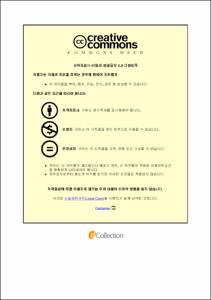Effect of two types of polymeric binders on the performance of high-capacity and solvent-free electrodes in lithium-ion batteries
- Abstract
- 리튬 이차전지는 스마트폰, 무선이어폰, 에너지 저장장치(ESS), 전기자동차와 같은 다양한 분야에 적용되며, 장수명, 고출력을 위한 고에너지 밀도를 갖춘 전지 소재 및 배터리 제조공정에 대한 연구가 활발하게 진행되고 있다. 이처럼 리튬 이온 배터리의 수요가 증가하며 배터리의 원가를 낮추기 위해 전지 소재 성능 향상 및 전지 제조공정 비용 절감 기술이 주목받고 있다.
전지 소재 측면에서 고용량 고출력의 차세대물질로 Si계 음극활물질의 부피팽창을 완화하며 전극에 높은 안정성과 성능 향상에 기여하는 바인더의 중요성이 대두되고 있다. 전지 제조공정 측면에서 고로딩의 전극을 제조할 수 있을 뿐만 아니라 기존의 습식공정 대비 많은 이점을 지니는 건식공정에 대한 연구가 활발히 진행되고 있다. 특히 건식 전극은 용매를 사용하지 않고 전극의 형태를 유지하기 위해 바인더의 역할이 매우 중요하다.
본 연구에서는 SiOx 5 % ~ 30 % 와 Graphite를 복합 음극활물질로 사용하여 상업용 수분산 바인더 SBR(styrene-bytadiene rubber), CMC(carboxy-methyl cellulose)에 적용하였을 때 최적 SiOx 비율을 연구했다. 이후 SiOx의 부피팽창에 대한 기계적 안정성을 부여하는 AM monomer와 AA monomer의 자유 라디칼 중합으로 제작된 P(AM-AA) 공중합체 바인더의 성능을 확인하고자 앞선 SiOx/C 최적 비율의 고용량 음극 전극에 적용했다. 중합한 바인더의 물리화학적 성능을 평가하기 위해 FT-IR, DSC, TGA, Rheology test, 전극저항 평가, 접착력 평가, 전해액 착수 등의 실험과 0.005 ~ 1.5 V 전압 범위에서 사이클 수명, 율속 특성, CV 분석, 임피던스 분석을 진행했다.
또한, 리튬이온 배터리 제조공정에서 기존 습식공정의 한계점을 극복하며 용매를 사용하지 않고 고로딩의 자립형 양극 건식 전극을 제작해 PTFE 고분자 바인더와 PVDF 고분자 바인더의 비율에 따른 건식 전극의 특성 평가 실험을 비교 분석했다. 고로딩의 건식 전극에 적용된 바인더의 물리화학적 성능을 평가하기 위해 전극저항 평가, 접착력 평가 SAICAS 등의 실험과 2.7 ~ 4.2 V 전압 범위에서 사이클 수명, 율속 특성, CV 분석, 임피던스 분석을 진행했다.
|Lithium-ion batteries (LIBs) are being used in various fields such as smartphones, wireless earphones, energy storage system, and electric vehicles. Intensive research efforts are currently being directed towards the development of battery materials and manufacturing techniques, with the goal of producing batteries that boast high energy density, extended longevity, and superior performance. With the rising demand for lithium-ion batteries, there is a growing focus on advancing technologies to enhance the performance of battery materials and to reduce the costs associated with the battery manufacturing process, ultimately aiming to decrease the overall cost of batteries.
Regarding battery materials, the significance of binders is coming to the forefront as a next-generation material. These binders are essential for high-capacity and high-output applications, as they mitigate the volume expansion in silicon-based anode active materials, thereby contributing to the enhanced stability and performance of electrodes. In terms of the battery manufacturing process there is active research on the dry process method. This approach is not only capable of producing high-loading electrodes but also offers numerous advantages compared to the traditional wet process. Specifically, in the case of dry electrodes, the role of the binder becomes crucial in maintaining the electrode's shape, especially as it eliminates the need for a solvent.
In this study, we investigated the optimal SiOx ratio for application in commercially available water-dispersed binders, namely SBR (styrene-butadiene rubber) and CMC (carboxymethyl cellulose). This was done using a composite anode active material comprised of 5 % to 30 % SiOx and graphite. Subsequently, to evaluate the performance of the P(AM-AA) copolymer binder, synthesized through free radical polymerization of AM and AA monomers, we applied it to a high-capacity cathode electrode. This was done to assess its mechanical stability against the volume expansion of SiOx, using the optimal SiOx/C ratio. To evaluate the physical and chemical performance of the polymerized binder, various experiments were conducted. These included FT-IR, DSC, TGA, rheology tests, evaluations of electrode resistance, adhesion tests, and analyses of electrolyte uptake. Additionally, to assess the cycling performance, rate capability, and CV test within the voltage range of 0.005 to 1.5 V, an EIS test was also performed.
Additionally, moving beyond the usual wet process used in making lithium-ion batteries, we created a high-capacity anode dry electrode without using solvents. We also carried out tests to see how the dry electrode behaves with different amounts of PTFE and PVDF polymer binders. To evaluate the physical performance of the binder applied to the high-loading dry electrode, experiments such as electrode resistance evaluation, adhesion tests, and SAICAS analyses were conducted. Additionally, to assess the cycling performance, rate capability, and CV test within the voltage range of 2.7 to 4.2 V, an EIS test was also performed.
- Issued Date
- 2024
- Awarded Date
- 2024-02
- Type
- Dissertation
- Alternative Author(s)
- Min-Jae Kim
- Affiliation
- 울산대학교
- Department
- 일반대학원 화학공학전공
- Advisor
- Eun-Suok Oh
- Degree
- Master
- Publisher
- 울산대학교 일반대학원 화학공학전공
- Language
- eng
- Rights
- 울산대학교 논문은 저작권에 의해 보호받습니다.
- Appears in Collections:
- Chemical Engineering > 1. Theses (Master)
- 파일 목록
-
-
Download
 200000737935.pdf
기타 데이터 / 3.26 MB / Adobe PDF
200000737935.pdf
기타 데이터 / 3.26 MB / Adobe PDF
-
Items in Repository are protected by copyright, with all rights reserved, unless otherwise indicated.